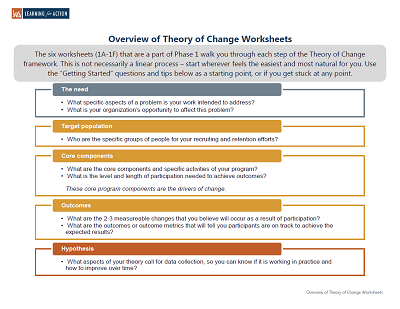Overview
A Theory of Change (TOC) is a living tool that links:
- What you do
- Who you are targeting for results
- Why and how you do it
- What you expect to achieve
- Who you are targeting for results
Developing a Theory of Change requires thoughtful conversations about how to strengthen programs. It structures your thinking and provides a platform to understand and measure results for learning and improvement.
"As a nonprofit, sometimes we can’t focus on evaluation work… [because of the TOC] it feels like it is becoming part of our culture, and is becoming institutionalized.”
- Environmental Education program leader
Photo credit:
Literacy for Environmental Justice
Theory of Change can help you:
- Clarify how change happens, what progress and success look like, and what it takes to get there
- Identify and account for factors that may affect success
- Know what resources are needed to create change
- Define what is within (and outside of) your “sphere of accountability”
- Know what questions to ask, what data to collect, and how to make decisions that lead to better results
Theory of Change is not:
- A static document that sits on a shelf (or file server)
- A straitjacket that stifles innovation
- An item to check off of your To Do list to satisfy external stakeholders
- A neat way to package up what you are doing now
- A straitjacket that stifles innovation
Photo credit: Richardson Bay Audubon Center & Sanctuary
- Meaningful: Does the TOC describe work that is compelling and meets an important need in a persuasive way?
- Plausible: Does evidence and common sense suggest that core program components will lead to desired change?
- Achievable: Are resources and time available to carry out the effort?
- Testable: Is the TOC sufficient, credible and useful in tracking and measuring progress and outcomes?
Theory of Change Components
Overview of Theory of Change worksheets.





